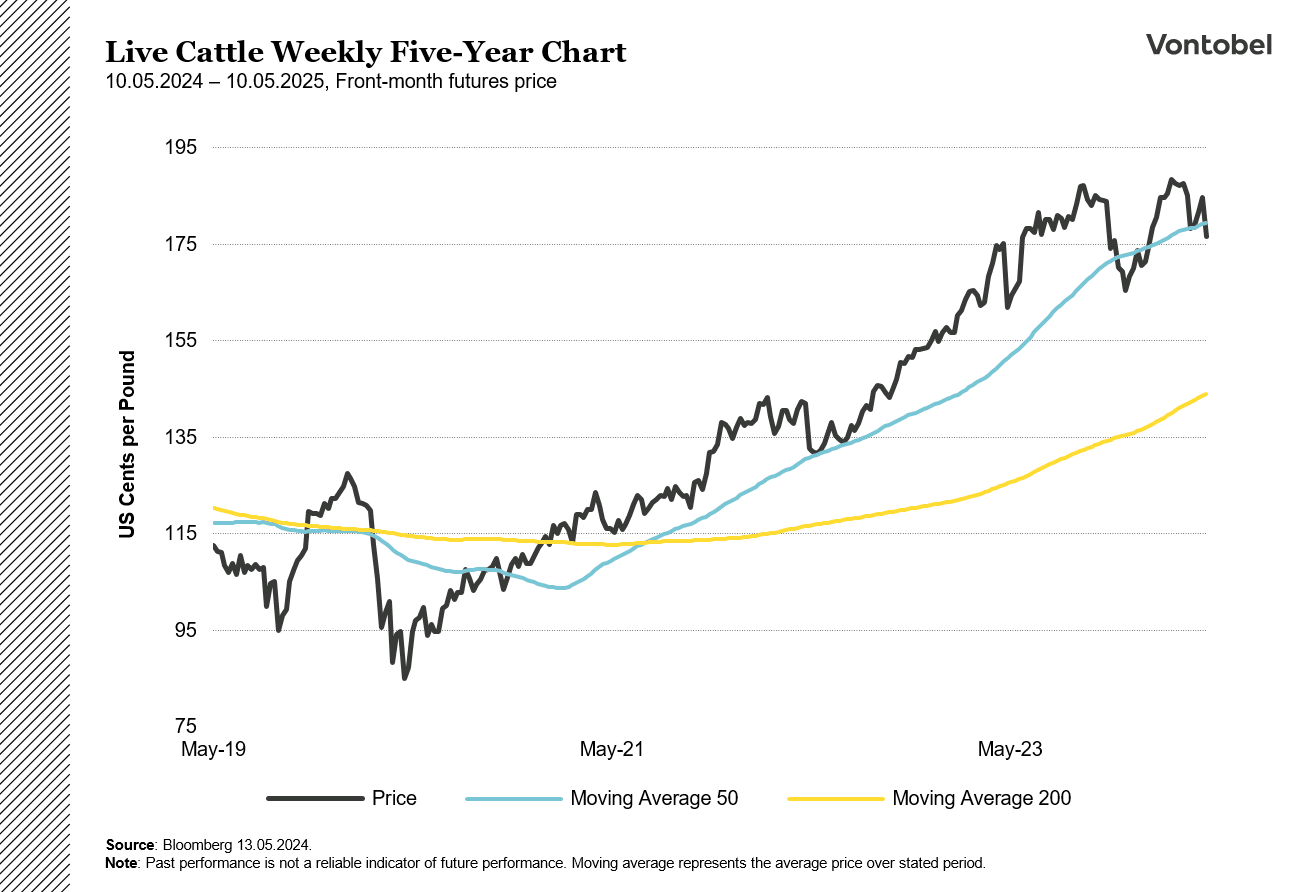Bi-weekly Commodity Insight

This week we return to the more classic commodities, with extra focus on agriculture where cattle and cocoa are leading the headlines. Meanwhile, there's a lot happening in the oil market due to a tense state of world affairs.
Turmoil in the United States
Live cattle prices have had a bit of a rollercoaster ride over the past year, with futures trading between 160 cents per pound up to 190 cents per pound which are near all-time highs. The cattle market, like other agricultural markets, is characterized by a strong correlation to weather, disease and other market factors.
The futures price that most affects the U.S. cattle market has moved from 190 cents per pound to 175 cents per pound over the past month. This decrease is based on the localized outbreaks of avian flu on US farms which has worried traders. Potential concerns about reduced demand and uncertainty about further outbreaks have resulted in the price stabilizing slightly around 175 cents per pound. However, the US Food and Drug Administration (USDA) assures that US producers are safe and that these are just localized outbreaks.

Will your chocolate bar be more expensive?
Importers of cocoa are finding it harder to secure longer contracts for cocoa beans as it becomes a scarcer commodity. Ghana's and Ivory Coast's harvests have been far below expectations due to the impact of the weather, resulting in importers rushing to secure supply and production as these two countries account for around 60% of total global supply. The futures curve is steeply downward sloping with shorter term contracts significantly more expensive, and the current futures (Cocoa May 2024) are trading above USD 8,500. This compares to Cocoa May 2025 trading down towards USD 6,500 on May 6, 2024.
The drop from the record levels of a little over 11,000 USD can be explained by rains that have fallen in the region but also a change in the structure of the futures traded on the Intercontinental Exchange, which changed the margin requirements on these contracts to limit the more speculative trading.
Many expect a continued volatile price going forward as demand and supply cannot be matched under current conditions, this has also led to countries in South America starting to plant cocoa to increase their production, which may lead to reduced volatility in the long run.

Oil as a hedge
Regardless of the turmoil in the world and the unrest in the Middle East, Brent and WTI prices are holding relatively steady. Many expected a price shock from Iran's response to Israel but there was no strong reaction from the market. This minor fluctuation in the price can be partly attributed to the fact that US production is at historic highs while US net imports are zero. US production now has a greater focus on shale oil which may have a stabilizing effect especially on WTI but also Brent.
Shale oil is generally more expensive to extract and refine, making producers more dependent on high oil prices to make ends meet. According to research by HSBC, the average producer needs an oil price of USD 66 per barrel in 2024 to break even. Technological developments and relatively high oil prices have led to a boom in production, greatly reducing US dependence on Middle Eastern oil over the past 10 years. This reduced dependence has shifted the dynamics of the oil market, making it less vulnerable to, for example, wars in the often war-torn Middle East. The WTI price has fallen from its 2022 peak of USD 130 a barrel down to USD 78 a barrel as of May 6.

Risks
Disclaimer:
This information is neither an investment advice nor an investment or investment strategy recommendation, but advertisement. The complete information on the trading products (securities) mentioned herein, in particular the structure and risks associated with an investment, are described in the base prospectus, together with any supplements, as well as the final terms. The base prospectus and final terms constitute the solely binding sales documents for the securities and are available under the product links. It is recommended that potential investors read these documents before making any investment decision. The documents and the key information document are published on the website of the issuer, Vontobel Financial Products GmbH, Bockenheimer Landstrasse 24, 60323 Frankfurt am Main, Germany, on prospectus.vontobel.com and are available from the issuer free of charge. The approval of the prospectus should not be understood as an endorsement of the securities. The securities are products that are not simple and may be difficult to understand. This information includes or relates to figures of past performance. Past performance is not a reliable indicator of future performance.
© Bank Vontobel Europe AG and/or its affiliates. All rights reserved.
Credit risk of the issuer:
Investors in the products are exposed to the risk that the Issuer or the Guarantor may not be able to meet its obligations under the products. A total loss of the invested capital is possible. The products are not subject to any deposit protection.
Market risk:
The value of the products can fall significantly below the purchase price due to changes in market factors, especially if the value of the underlying asset falls. The products are not capital-protected
Risk with leverage products:
Due to the leverage effect, there is an increased risk of loss (risk of total loss) with leverage products, e.g. Bull & Bear Certificates, Warrants and Mini Futures.
Product costs:
Product and possible financing costs reduce the value of the products.
Currency risk:
If the product currency differs from the currency of the underlying asset, the value of a product will also depend on the exchange rate between the respective currencies. As a result, the value of a product can fluctuate significantly.
